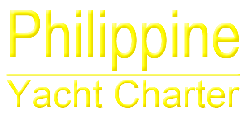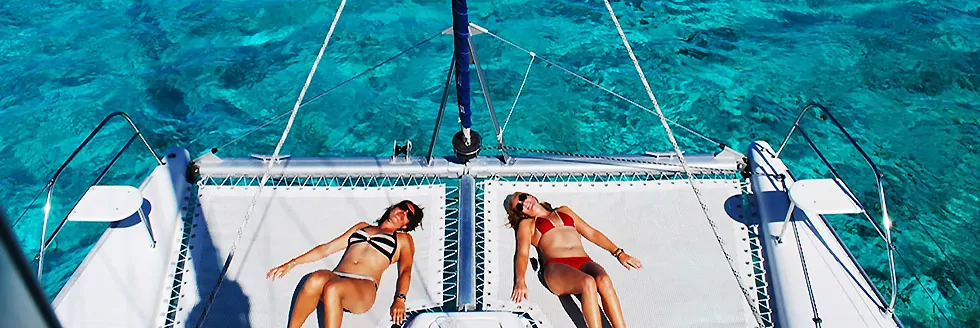Philippine Weather & Tides
Sailing Weather Forecast Philippines
Philippine sailing weather forecasts are easy to obtain on the Internet for predicting the weather up to ten days ahead. The weather forecast link below offers a forecast that we have found to be about 90% accurate, except when there are thunderstorms around - when the local conditions and micro-climates may vary considerably from the weather generated by the gradient wind.
Philippines Sailing Weather: Overview
Sailing weather in the Philippines is dominated by two seasons: the "amihan" (northeast monsoon); and, the "habagat" (southwest monsoon). In general, the best sailing weather for cruising in the Philippines occurs between late October through to the end of May – the northeast monsoon brings light to moderate sailing breezes with generally clear skies and little rain. By contrast, the southwest monsoon (June through early October) typically delivers moderate to strong sailing breezes and frequent thunderstorms or periods of afternoon rain.
Tropical storms and typhoons may develop over the West Pacific at any time of year but are most frequent between July and November. In general, the more powerful storms occur during the period of September to November. On average, the Philippines is directly affected by about 60% of the West Pacific tropical storms. However, in recent years most of the storms turn North early, missing the East coast of the Philippines completely, and do nothing more than generate a lot of rain.
Climate change in general, plus natural cycles such as the El Niño and La Niña, affect the frequency, track and power of tropical storms. The most noticeable change in the past ten years has been the increased volume of rain associated with the storms when they pass over land. Typhoon warnings can be found in number of Internet resources but most rely on the U.S. Navy services for the most accurate tropical storm forecasts in the West Pacific.
Other Weather Resources
It is worth noting that the southern half of the Philippines, from the latitude of Cebu to southern Mindanao, statistically receive the fewest tropical storms. Records in the area of the Davao Gulf show that it has never been significantly affected by tropical storms.
Tide Ranges, Tidal Flow & Tide Tables
The Philippines is fortunate in that tide ranges are relatively small. Tide ranges in the Philippines are typically between one and two metres, daily.
Tidal flows are generally not significant factors in planning a voyage. However, there are a few areas (see below) where tidal flows can reach up to seven knots and these should be the subject of careful route planning.
Tide tables are available from a number of resources on the Internet. We recommend tidecharts.com/Philippines, just type in the name of the nearest sea-port . . . they also offer information about the best fishing times.
Three Significant Tidal Flows
The Philippines (and the island of Luzon in particular) offers a very long, land barrier to the general East-to-West ocean flow, from the Pacific to the Indian oceans. As a consequence, fast tidal flows will be found at: the extreme North of the Philippines, between Santa Ana (Cagayan, Luzon) and through the Babuyan Channel islands; through the San Bernardino Strait, between southern Luzon and the North of Samar Island; and, the Surigao Strait, between Leyte Island and the islands around northeast Mindanao (Siargao & Dinagat island groups). Tidal flows of up to seven knots have been recorded at these locations, so route planning is essential unless you want to go nowhere while achieving a boat speed of seven knots.
Other Significant Tidal Flows
Between some islands there may be tidal flows that can be significant by virtue of their speed (up to three knots) or by virtue of the surrounding topography, where locally strong winds may affect the wave form.
One notorious area - the Calavite Passage - towards the West of the Verde Island Passage (between Batangas and northwest portion of Mindoro Island), can deliver tidal flows of two knots but the wind funnel (by virtue of the high mountains on Mindoro) can cause very unpleasant square, wave troughs of up to eight feet, when peak-tide opposes strong wind. Best advice is to approach the Calavite Passage at slack-tide or when tide and wind are moving in the same direction.
Another area where tidal flows may be significant is between the southern portion of Tablas Island and the islands of Carabao and Boracay. Here, East-to-West tidal flows at peak-tide may be as much as four knots and can require a change of heading of up to 30 degrees in order to maintain a desired North/South track.
For the smoothest passage sailing in all cases, when your planned route passes between islands (of significant by size or height), we recommend choosing a time of day when the wind and tidal flow are forecast to be in the same direction.
need detailed info? contact Philippine Yacht Charter with questions
Copyright © 2009-2024 Philippine Yacht Charter; All Rights Reserved


